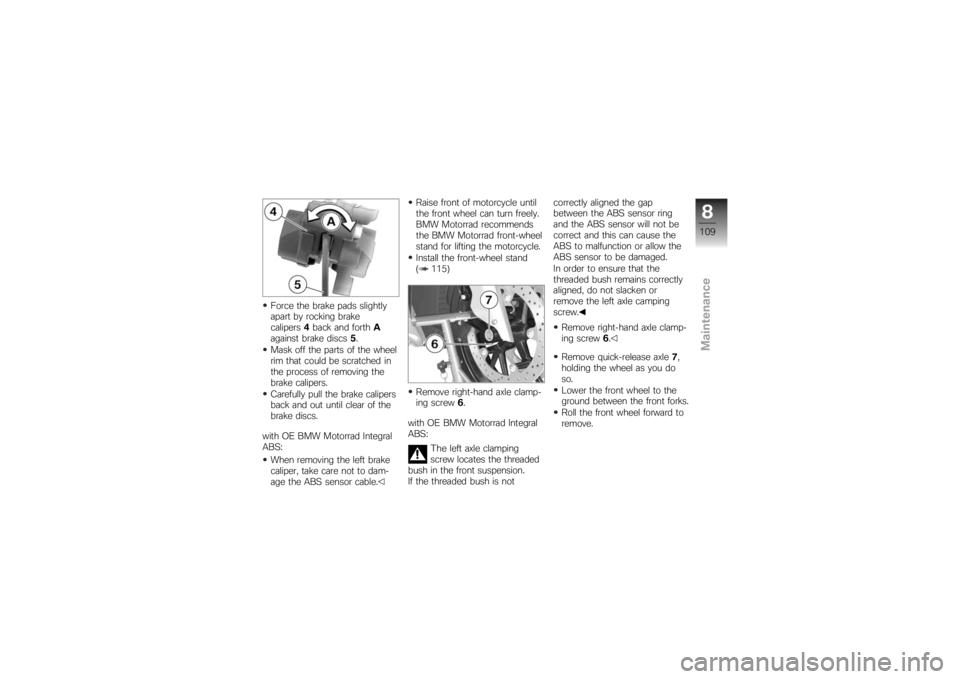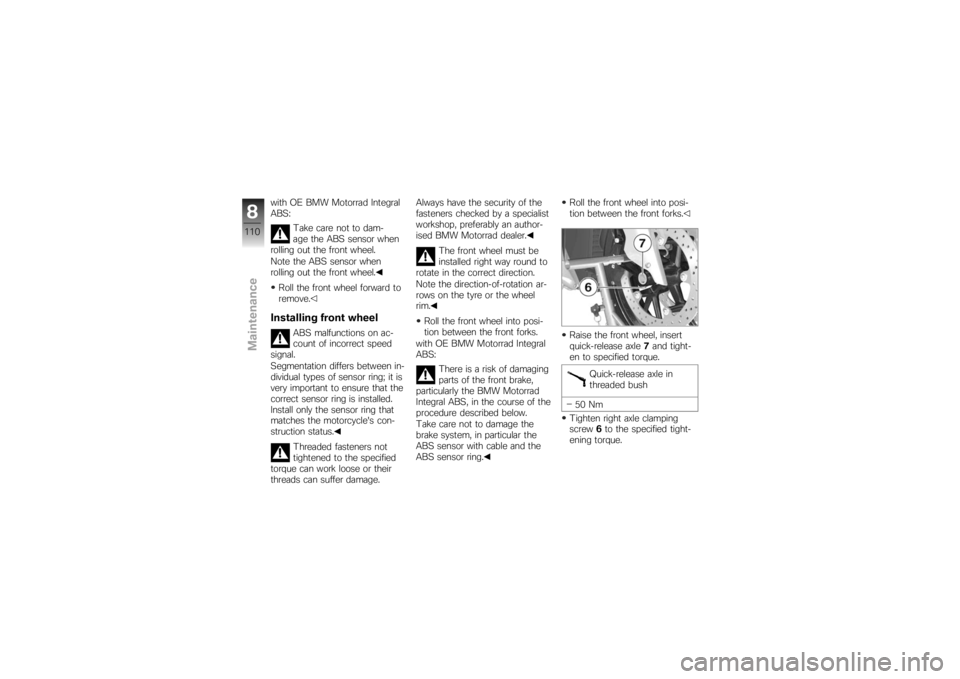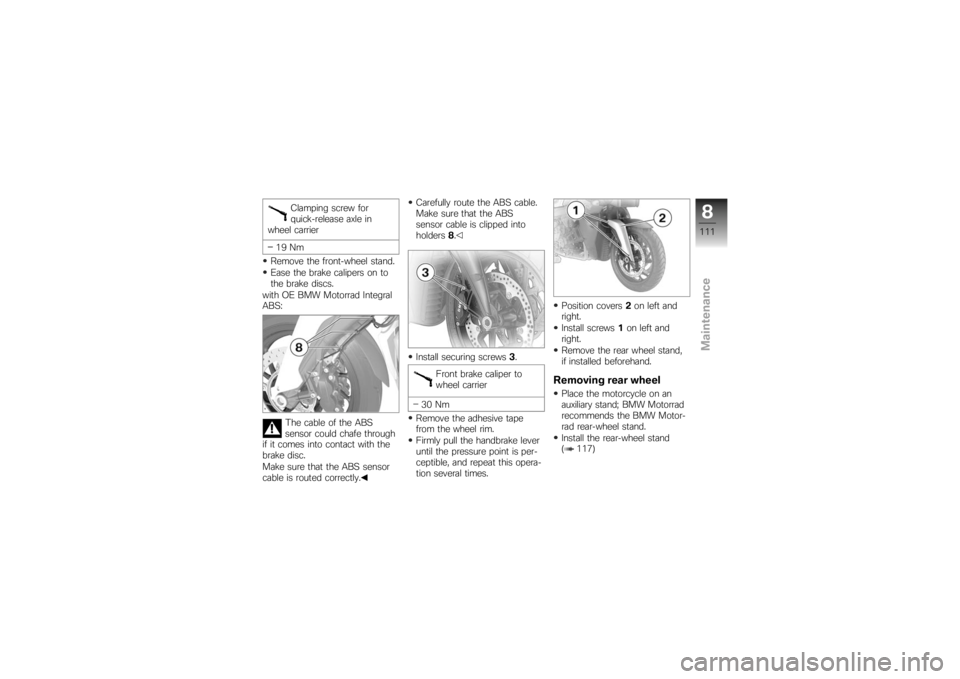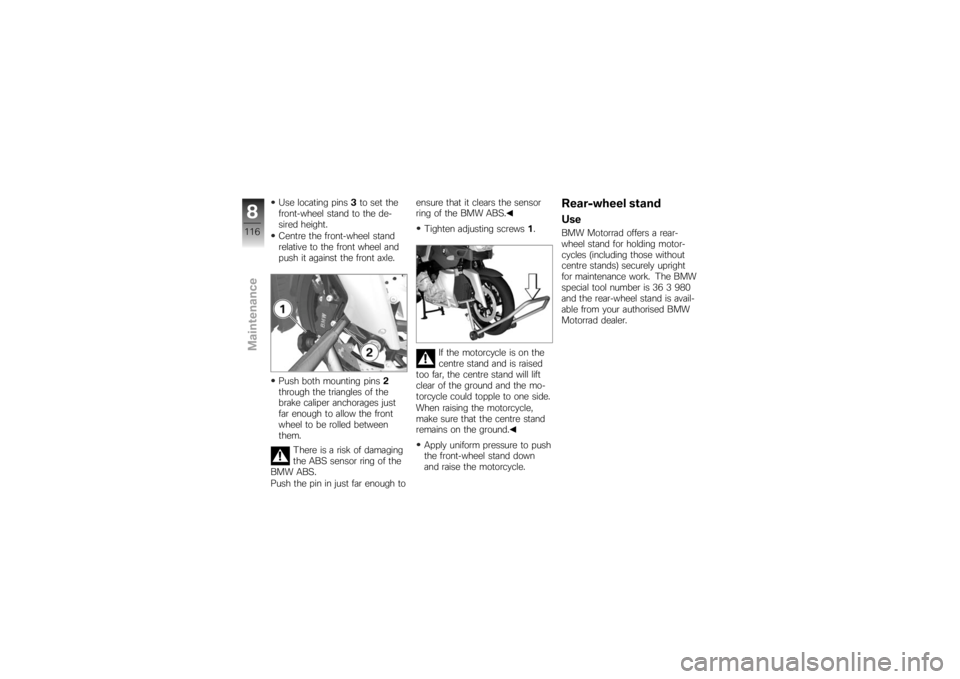2007 BMW MOTORRAD K 1200 R ABS
[x] Cancel search: ABSPage 83 of 168

Engineering details
Engineering details
Brake system with BMW Motorrad
Integral ABS
OE
...................... 82
Electronic engine management with
BMW Motorrad ASC
OE
.............. 84
Tyre pressure monitoring
RDC
OE
.............................. 86
681zEngineering details
Page 84 of 168

Brake system with
BMW Motorrad Integral
ABS
OE
Partially integral brakesYour motorcycle is equipped with
partially integral brakes. Both
front and rear brakes are applied
when you pull the handbrake
lever. The footbrake lever acts
only on the rear brake.
While the brakes are slowing the
motorcycle, the BMW Motorrad
Integral ABS adapts braking-force
distribution between front and
rear brakes to suit the load on
the motorcycle.The integral braking func-
tion makes it very difficult
to spin the rear wheel by opening
the throttle with the front brake
applied to keep the motorcycle
stationary (burn-out). Attempted
burn-outs can result in damage
to the rear brake and the clutch.
Do not attempt burn-outs.
How does ABS work?The amount of braking force that
can be transferred to the road
depends on factors hat include
the coefficient of friction of the
road surface. Loose stones, ice
and snow or a wet road all have
much lower coefficients of fric-
tion than a clean, dry asphalt sur-
face. The lower the coefficient
of friction, the longer the braking
distance.
If the rider increases braking
pressure to the extent that brak-
ing force exceeds the maxim-
um transferrable limit, the wheels
start to lock and the motorcycle
loses its directional stability; a fall
is imminent. Before this situation
can occur, ABS intervenes and
adapts braking pressure to the
maximum transferrable braking
force, so the wheels continue
to turn and directional stability
is maintained irrespective of the
condition of the road surface.
What are the effects of
surface irregularities?Humps and surface irregular-
ities can cause the wheels to
lose contact temporarily with the
road surface; if this happens the
braking force that can be trans-
mitted to the road can drop to
zero. If the brakes are applied
under these circumstances the
ABS has to reduce braking force
to ensure that directional sta-
bility is maintained when the
wheels regain contact with the
road surface. At this instant the
BMW Motorrad Integral ABS
must assume an extremely low
coefficient of friction, so that the
wheels will continue to rotate un-
der all imaginable circumstances,
because this is the precondition
for ensuring directional stability.
As soon as is registers the ac-
tual circumstances, the system
reacts instantly and adjusts brak-
682zEngineering details
Page 85 of 168

ing force accordingly to achieve
optimum braking.What feedback does the
rider receive from the
BMW Motorrad Integral
ABS?If the ABS system has to reduce
braking force on account of the
circumstances described above,
vibration is perceptible through
the handbrake lever.
When the handbrake lever is
pulled, brake pressure is also
built up at the rear wheel by
the integral function. If the
brake pedal is depressed after
the handbrake lever is pulled,
the brake pressure built up
beforehand is perceptible as
counter-pressure sooner than is
the case when the brake pedal is
depressed either before or at the
same time as the brake lever is
pulled.
Rear wheel liftEven under severe braking, a
high level of tyre grip can mean
that the front wheel does not
lock up until very late, if at all.
Consequently, ABS does not in-
tervene until very late, if at all.
Under these circumstances the
rear wheel can lift off the ground,
and the outcome can be a high-
siding situation in which the mo-
torcycle can flip over.Severe braking can cause
the rear wheel to lift off the
ground.
When you brake, bear in mind
that ABS control cannot be relied
on in all circumstances to prevent
the rear wheel from lifting clear of
the ground.
What is the design
baseline for BMW
Motorrad Integral ABS?Within the limits imposed by
physics, the BMW Motorrad In-
tegral ABS ensures directional
stability on any surface. The sys-
tem is not optimised for special
requirements that apply under
extreme competitive situations
off-road or on the track.Special situationsThe speeds of the front and rear
wheels are compared as one
means of detecting a wheel's
incipient tendency to lock. If the
system registers implausible val-
ues for a lengthy period the ABS
function is deactivated for safety
reasons and an ABS fault mes-
sage is issued. Self-diagnos-
is has to complete before fault
messages can be issued.
In addition to problems with the
BMW Motorrad Integral ABS,
683zEngineering details
Page 86 of 168

exceptional riding conditions can
lead to a fault message being
issued.
Exceptional riding
conditions:Heating up with the motorcycle
on the centre stand or an auxil-
iary stand, engine idling or with
a gear engaged.
Rear wheel locked by the en-
gine brake for a lengthy period,
for example while descending
off-road.
If a fault message is issued on
account of exceptional riding
conditions as outlined above, you
can reactivate the ABS function
by switching the ignition off and
on again.
What significance
devolves on regular
maintenance?
Invariably, a technical sys-
tem cannot perform beyond
the abilities dictated by its level
of maintenance.
In order to ensure that the BMW
Motorrad ABS is always main-
tained in optimum condition, it
is essential for you to comply
strictly with the specified inspec-
tion intervals.
Reserves for safetyThe potentially shorter braking
distances which BMW Motorrad
Integral ABS permits must not be
used as an excuse for careless
riding. ABS is primarily a means
of ensuring a safety margin in
genuine emergencies.
Take care when cornering. When
you apply the brakes on a corner,
the motorcycle's weight and momentum take over and even
BMW Motorrad Integral ABS is
unable to counteract their effects.
Electronic engine
management with BMW
Motorrad ASC
OE
How does ASC work?The BMW Motorrad ASC com-
pares the speed of rotation of the
front wheel and the rear wheel.
The differential is used to com-
pute slip as a measure of the
reserves of stability available at
the rear wheel. If slip exceeds a
certain limit the electronic engine
management system intervenes,
adapting engine torque accord-
ingly.
684zEngineering details
Page 111 of 168

Force the brake pads slightly
apart by rocking brake
calipers4back and forth A
against brake discs 5.
Mask off the parts of the wheel
rim that could be scratched in
the process of removing the
brake calipers.
Carefully pull the brake calipers
back and out until clear of the
brake discs.
with OE BMW Motorrad Integral
ABS: When removing the left brake
caliper, take care not to dam-
age the ABS sensor cable. Raise front of motorcycle until
the front wheel can turn freely.
BMW Motorrad recommends
the BMW Motorrad front-wheel
stand for lifting the motorcycle.
Install the front-wheel stand
( 115)
Remove right-hand axle clamp-
ing screw
6.
with OE BMW Motorrad Integral
ABS: The left axle clamping
screw locates the threaded
bush in the front suspension.
If the threaded bush is not correctly aligned the gap
between the ABS sensor ring
and the ABS sensor will not be
correct and this can cause the
ABS to malfunction or allow the
ABS sensor to be damaged.
In order to ensure that the
threaded bush remains correctly
aligned, do not slacken or
remove the left axle camping
screw.
Remove right-hand axle clamp-
ing screw 6.
Remove quick-release axle 7,
holding the wheel as you do
so.
Lower the front wheel to the
ground between the front forks.
Roll the front wheel forward to
remove.
8109zMaintenance
Page 112 of 168

with OE BMW Motorrad Integral
ABS:Take care not to dam-
age the ABS sensor when
rolling out the front wheel.
Note the ABS sensor when
rolling out the front wheel.
Roll the front wheel forward to
remove.Installing front wheel
ABS malfunctions on ac-
count of incorrect speed
signal.
Segmentation differs between in-
dividual types of sensor ring; it is
very important to ensure that the
correct sensor ring is installed.
Install only the sensor ring that
matches the motorcycle's con-
struction status.
Threaded fasteners not
tightened to the specified
torque can work loose or their
threads can suffer damage. Always have the security of the
fasteners checked by a specialist
workshop, preferably an author-
ised BMW Motorrad dealer.
The front wheel must be
installed right way round to
rotate in the correct direction.
Note the direction-of-rotation ar-
rows on the tyre or the wheel
rim.
Roll the front wheel into posi-
tion between the front forks.
with OE BMW Motorrad Integral
ABS:
There is a risk of damaging
parts of the front brake,
particularly the BMW Motorrad
Integral ABS, in the course of the
procedure described below.
Take care not to damage the
brake system, in particular the
ABS sensor with cable and the
ABS sensor ring. Roll the front wheel into posi-
tion between the front forks.
Raise the front wheel, insert
quick-release axle
7and tight-
en to specified torque.
Quick-release axle in
threaded bush
50 Nm
Tighten right axle clamping
screw 6to the specified tight-
ening torque.
8110zMaintenance
Page 113 of 168

Clamping screw for
quick-release axle in
wheel carrier
19 Nm
Remove the front-wheel stand.
Ease the brake calipers on to
the brake discs.
with OE BMW Motorrad Integral
ABS:
The cable of the ABS
sensor could chafe through
if it comes into contact with the
brake disc.
Make sure that the ABS sensor
cable is routed correctly. Carefully route the ABS cable.
Make sure that the ABS
sensor cable is clipped into
holders
8.
Install securing screws 3.
Front brake caliper to
wheel carrier
30 Nm
Remove the adhesive tape
from the wheel rim.
Firmly pull the handbrake lever
until the pressure point is per-
ceptible, and repeat this opera-
tion several times. Position covers
2on left and
right.
Install screws 1on left and
right.
Remove the rear wheel stand,
if installed beforehand.
Removing rear wheelPlace the motorcycle on an
auxiliary stand; BMW Motorrad
recommends the BMW Motor-
rad rear-wheel stand.
Install the rear-wheel stand
( 117)
8111zMaintenance
Page 118 of 168

Use locating pins3to set the
front-wheel stand to the de-
sired height.
Centre the front-wheel stand
relative to the front wheel and
push it against the front axle.
Push both mounting pins 2
through the triangles of the
brake caliper anchorages just
far enough to allow the front
wheel to be rolled between
them.
There is a risk of damaging
the ABS sensor ring of the
BMW ABS.
Push the pin in just far enough to ensure that it clears the sensor
ring of the BMW ABS.
Tighten adjusting screws 1.
If the motorcycle is on the
centre stand and is raised
too far, the centre stand will lift
clear of the ground and the mo-
torcycle could topple to one side.
When raising the motorcycle,
make sure that the centre stand
remains on the ground.
Apply uniform pressure to push
the front-wheel stand down
and raise the motorcycle.
Rear-wheel standUseBMW Motorrad offers a rear-
wheel stand for holding motor-
cycles (including those without
centre stands) securely upright
for maintenance work. The BMW
special tool number is 36 3 980
and the rear-wheel stand is avail-
able from your authorised BMW
Motorrad dealer.
8116zMaintenance